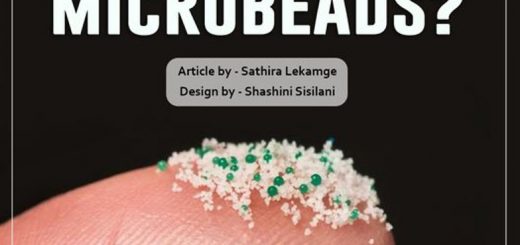Impact of Microplastics on Human Health
When we get up in the morning, we usually brush our teeth, wash our face with a face wash and probably wash our hair using shampoos and rinse them away. Have you ever thought that these actions can cause serious health defects to our own health?
Rinse off cosmetics, toothpaste, scrubs, lipsticks, mascara, shampoos, personal care and cleaning products are some of the products that contain microbeads in them. We also produce tiny plastic fibers and particles whilst we wash garments, power our cars, wear down carpets and upholstered fixtures and etc. Most of the wastewater management systems are unable to capture these microplastics. Therefore, scientists have discovered microplastics in every corner of the planet including oceans and freshwater Eco-systems. These microplastics have damaging effects on marine life, the environment and human health. That is due to their composition, potential to soak up toxins and their capacity to transfer up the marine food chain. Microplastics in aquatic systems can be ingested by marine life and they can walk their way up the marine food chain, ultimately leading to humans. Also, microplastics are detected in human consumption products such as drinking water, table salt, sea food such as fish, oysters, crabs, mussels etc.
Scientists say microplastics can reach our stomach, and relying on their size, those plastics are both excreted, get entrapped in belly and intestinal lining or pass freely in body fluids consisting of blood, thereby reaching diverse organs and tissues of the human body. Ingested microplastics can physically damage organs and leach hazardous chemicals. The internal organs that are most commonly affected are the liver, the kidneys, the heart, the nervous system (including the brain) and the reproductive system. Recent studies have showed that microplastics can aggregate in blood, which will obstruct the flow of the blood and make blood proteins nonfunctional.
Microplastics can leach out bisphenol A (BPA) and phthalates which can affect the hormones in human body. These chemicals are found out to reduce fertility in men and women. BPA also can disturb alpha and beta receptors in fat tissues, affecting fat tissue hormones levels. It can induce breast and prostate cancers in humans. BPA can trans-locate to different organs and can cause liver function alternation, insulin resistance and decreased brain function. On the other hand, phthalate esters can cause birth defects, abnormal sexual development, and even cancer.
Microplastics can also accumulate polychlorinated biphenyls (PCBs) inside human body, which has harmful health effects such as a weakened immune system, cancers, and dis-functions in reproductive systems. Exposure to microplastics is linked with tumors as well. As a result of chronic inflammation and irritation, microplastics can promote cancers due to DNA damage.
Microplastics and microbeads from toothpaste and personal care products can also be absorbed via skin, the mucous membrane, and gastrointestinal mucosa. They are associated with skin damage due to local inflammation and cytotoxicity. Microplastics could cause oxidative stress by releasing oxidizing chemicals (such as metals) adsorbed to their surface and reactive oxygen radicals from the host body that were produced during the inflammatory response.
Due to high surface area of microplastics, microorganisms can colonize on the surface of microplastics. So, when these are ingested into the human body, they can carry harmful pathogens with them into the human body while creating tissue damage which results in infections. Also, it can alter gut microbiome, which can cause rapid reproduction of harmful pathogens and increase in intestinal permeability to harmful pathogens.
Therefore, looking at these negative impacts on human health, we should all come together to take necessary actions to reduce plastic use and support policies that limit plastic pollution.
All of us must remember that what goes around comes around.
References
1. Schirinzi, Gabriella F.; Pérez-Pomeda, Ignacio; Sanchís, Josep; Rossini, Cesare; Farré, Marinella; Barceló, Damià (2017). Cytotoxic effects of commonly used nanomaterials and microplastics on cerebral and epithelial human cells. Environmental Research, 159 579–587. doi:10.1016/j.envres.2017.08.043
2. De-la-Torre, Gabriel Enrique (2019). Microplastics: an emerging threat to food security and human health. Journal of Food Science and Technology, , –. doi:10.1007/s13197-019-04138-1
3. Sharma, Shivika; Chatterjee, Subhankar (2017). Microplastic pollution, a threat to marine ecosystem and human health: a short review. Environmental Science and Pollution Research, , –. doi:10.1007/s11356-017-9910-8
4. Rahman, Arifur; Sarkar, Atanu; Yadav, Om Prakash; Achari, Gopal; Slobodnik, Jaroslav (2020). Potential human health risks due to environmental exposure to microplastics and knowledge gaps: a scoping review. Science of The Total Environment, , 143872–. doi:10.1016/j.scitotenv.2020.143872
5. Prata, Joana Correia; da Costa, João P.; Lopes, Isabel; Duarte, Armando C.; Rocha-Santos, Teresa (2019). Environmental exposure to microplastics: an overview on possible human health effects. Science of The Total Environment, , 134455–. doi:10.1016/j.scitotenv.2019.134455
6. Kontrick, Amy V. (2018). Microplastics and Human Health: Our Great Future to Think About Now. Journal of Medical Toxicology, , s13181-018-0661-9–. doi:10.1007/s13181-018-0661-9



